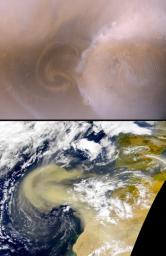
|
Recent Mars and Earth Dust Storms Compared
- Click the image above for a larger view
- Full-Res JPEG (885 x 1369) (164.4 kB)
- Full-Res TIFF (885 x 1369) (3.5 MB)
Caption:
Spring on Mars...in either hemisphere...is a time for local and regional dust storms. These storms arise as the seasonal carbon dioxide frost cap, which can extend almost half-way to the equator, sublimes in the warming spring environment. Several factors promote these dust storms:
- the atmospheric pressure is increasing as carbon dioxide frost CO 2 sublimes--higher pressure allows more dust to be suspended, and for a longer time;
- the temperature contrast between the frost covered surface and immediately adjacent, recently defrosted surfaces is quite high, creating thermally-generated winds that circulate onto and off of the frost cap edge;
- similar, temperature-driven winds arise as sublimation of frost covering sun-facing slopes and dark sandy surfaces deep within the polar region creates intense slope winds away from the higher-standing layered deposits and permanent cap.
The roughly circular, polar orbit of the Mars Global Surveyor (MGS) spacecraft affords a view not unlike that seen by low Earth-orbiting environmental satellites. Mars is roughly 6800 km (4226 mi) in diameter, and a 370 km (230 mi) average altitude gives a diameter to altitude ratio for MGS of 18.4:1. For comparison, the SeaStar spacecraft in Earth orbit follows a very similar orbit: it's the diameter to altitude ratio is 17.5:1 (12,760 km or 7,928 mi diameter relative to a 705 km or 438 mi altitude). Each spacecraft covers the entire planet in 12 orbits.
In this figure, we compare a recent dust storm on Mars with one that occurred earlier this year on Earth. The top image shows a martian north polar dust storm observed on 29 August 2000. This image is part of the Mars Orbiter Camera (MOC) daily global map--a low resolution, two-color view of Mars acquired from pole to pole every orbit. The storm is moving as a front, outward from a central "jet," and marginal "vortices" can be seen. In this image it extends about 900 km (560 mi) out from the north polar seasonal frost cap. The region on the right side of the Mars picture includes the north pole. The bottom image shows a terrestrial dust storm, seen in a SeaWiFS image, acquired on 26February 2000. This storm extends about 1800 km (1100 mi) off the coast of northwest Africa near the Earth's equator. Both images are shown at the same scale; 4 km (2.5 mi) per pixel.
Dust storms play an important role in governing the climate of Mars. The rare, global storms alter the planet's total heat balance and promote variations in seasonal frost formation and dissipation, and greatly affect the distribution of water vapor. Local and regional storms, especially those in the polar regions, affect the rate at which seasonal frost evolves, and control local and regional weather patterns. On Earth, dust storms are also being recognized as contributing to environmental change, potentially influencing seasonal meteorology and the health of biological communities.
Cataloging Keywords:
| Name | Value | Additional Values |
|---|---|---|
| Target | Mars | |
| System | ||
| Target Type | Planet | |
| Mission | Mars Global Surveyor (MGS) | |
| Instrument Host | Mars Global Surveyor | |
| Host Type | Orbiter | |
| Instrument | Mars Orbiter Camera (MOC) | |
| Detector | ||
| Extra Keywords | Atmosphere, Color, Dust, Map, Storm, Thermal, Water | |
| Acquisition Date | ||
| Release Date | 2000-09-12 | |
| Date in Caption | 2000-08-29 | |
| Image Credit | NASA/JPL/MSSS | |
| Source | photojournal.jpl.nasa.gov/catalog/PIA02807 | |
| Identifier | PIA02807 | |
